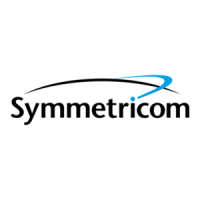098-00028-000 Revision F – May, 2012 TimeProvider 5000 User’s Guide 373
Chapter 6 Maintenance and Troubleshooting
Troubleshooting
Troubleshooting
Symptoms, LEDs, and System Messages can all be very helpful in troubleshooting
the TP5000. Use the “show alarm” and “show event” commands to view system
messages.
Table 6-2 presents troubleshooting information for the TP5000 based on symptoms.
Table 6-3 presents diagnostic information for the IOC card using on front panel
LEDs. Table 6-4 presents diagnostic information for the IMC card based on front
panel LEDs. See Table A-1 in Appendix A, System Messages for Event IDs, system
messages and associated corrective actions.
Table 6-2. Troubleshooting Symptoms
Symptom Probable Cause
Troubleshooting Procedure /
Corrective Action
No LED lit on any module No power to unit Check power supply
Check to ensure that UPS (if applicable) is
operating correctly
Both A and B fuses on
the branch over-current
protection unit are blown
Remove both fuses and replace
Loss of ground Re-attach ground wires
Loose power cabling to
unit
Check that power cables to unit are
securely fastened
Chassis is faulty Contact Symmetricom Global Services
No PTP flow between
TP5000 Grandmaster
and client
(
If LED for port is OFF:)
Cable connections Check the cable connections and SFP
connections.
Verify that SFP connector models are
recommended and supported.
Ethernet Auto Negotiation
settings
Check that either Ethernet Auto
Negotiation is enabled or that speed has
been set to a compatible level with the
connecting network element (
show eth
config
command).
Make sure that only full-duplex network
devices are used. The TP5000 does not
support half-duplex devices, such as
hubs, for PTP connections.

